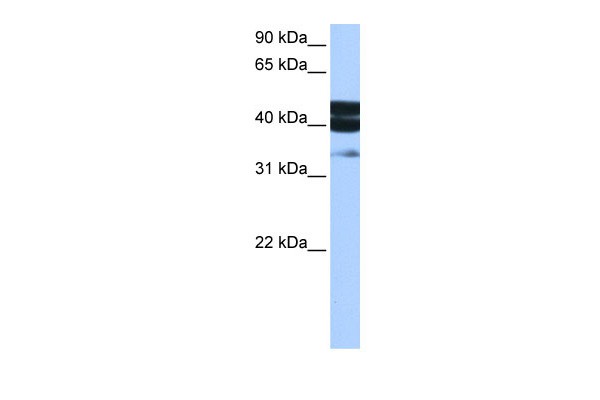Lane 1: 5ug of transfected 293T lysate (SMAD1)
Lane 1: 5ug of transfected 293T lysate (SMAD2)
Lane 1: 5ug of transfected 293T lysate (SMAD3)
Lane 1: 5ug of transfected 293T lysate (SMAD4)
Lane 1: 5ug of transfected 293T lysate (SMAD5)
Lane 1: 5ug of transfected 293T lysate (SMAD6)
Lane 1: 5ug of transfected 293T lysate (SMAD7)
Lane 1: 5ug of transfected 293T lysate (SMAD8)
Lane 1: 5ug of transfected 293T lysate (GFP)
Primary Antibody Dilution:
1:1000
Secondary Antibody:
Goat anti-Rabbit IgG HRP Conjugated
Secondary Antibody Dilution:
1:10,000
Gene Name:
SMAD1
Submitted by:
Amanda Urick, Medical College of Wisconsin
0.2-1 ug/ml
Positive Control: MCF7 cell lysate
Product Profile
| Product Name | Rabbit anti-SMAD1 polyclonal antibody - middle region |
|---|---|
| Antibody Type | Primary Antibodies |
| Immunogen | The immunogen for anti-SMAD1 antibody: synthetic peptide directed towards the middle region of human SMAD1 |
Key Feature
| Clonality | Polyclonal |
|---|---|
| Isotype | IgG |
| Host Species | Rabbit |
| Tested Applications | |
WB:1:500~1:2000 Notes:Optimal dilutions/concentrations should be determined by the researcher. |
|
| Species Reactivity | |
| Concentration | 1 mg/ml |
| Purification | Affinity purified |
Target Information
| Gene Symbol | SMAD1 |
|---|---|
| Gene Synonyms | BSP1 JV4-1 JV41 MADH1 MADR1 BSP-1 |
| Gene Full Name | SMAD family member 1 |
| Gene Summary | SMAD1 belongs to the SMAD family. SMAD proteins are signal transducers and transcriptional modulators that mediate multiple signaling pathways. SMAD1 mediates the signals of the bone morphogenetic proteins (BMPs), which are involved in a range of biological activities including cell growth, apoptosis, morphogenesis, development and immune responses. In response to BMP ligands, SMAD1 can be phosphorylated and activated by the BMP receptor kinase. The phosphorylated form of SMAD1 forms a complex with SMAD4, which is important for its function in the transcription regulation. SMAD1 is a target for SMAD-specific E3 ubiquitin ligases, such as SMURF1 and SMURF2, and undergoes ubiquitination and proteasome-mediated degradation.The protein encoded by this gene belongs to the SMAD, a family of proteins similar to the gene products of the Drosophila gene 'mothers against decapentaplegic' (Mad) and the C. elegans gene Sma. SMAD proteins are signal transducers and transcriptional modulators that mediate multiple signaling pathways. This protein mediates the signals of the bone morphogenetic proteins (BMPs), which are involved in a range of biological activities including cell growth, apoptosis, morphogenesis, development and immune responses. In response to BMP ligands, this protein can be phosphorylated and activated by the BMP receptor kinase. The phosphorylated form of this protein forms a complex with SMAD4, which is important for its function in the transcription regulation. This protein is a target for SMAD-specific E3 ubiquitin ligases, such as SMURF1 and SMURF2, and undergoes ubiquitination and proteasome-mediated degradation. Alternatively spliced transcript variants encoding the same protein have been observed.The protein encoded by this gene belongs to the SMAD, a family of proteins similar to the gene products of the Drosophila gene 'mothers against decapentaplegic' (Mad) and the C. elegans gene Sma. SMAD proteins are signal transducers and transcriptional modulators that mediate multiple signaling pathways. This protein mediates the signals of the bone morphogenetic proteins (BMPs), which are involved in a range of biological activities including cell growth, apoptosis, morphogenesis, development and immune responses. In response to BMP ligands, this protein can be phosphorylated and activated by the BMP receptor kinase. The phosphorylated form of this protein forms a complex with SMAD4, which is important for its function in the transcription regulation. This protein is a target for SMAD-specific E3 ubiquitin ligases, such as SMURF1 and SMURF2, and undergoes ubiquitination and proteasome-mediated degradation. Alternatively spliced transcript variants encoding the same protein have been observed. |
| Alternative Names | BSP1 JV4-1 JV41 MADH1 MADR1 BSP-1 |
| Molecular Weight(MW) | 52kDa |
| Sequence | 465 amino acids |
Database Links
| Entrez Gene | 4086 |
|---|---|
| SwissProt ID | Q15797 |
| Protein Accession | NP_005891 |
Application
-
Immunoblot
Lane 1: 5ug of transfected 293T lysate (SMAD1)
Lane 1: 5ug of transfected 293T lysate (SMAD2)
Lane 1: 5ug of transfected 293T lysate (SMAD3)
Lane 1: 5ug of transfected 293T lysate (SMAD4)
Lane 1: 5ug of transfected 293T lysate (SMAD5)
Lane 1: 5ug of transfected 293T lysate (SMAD6)
Lane 1: 5ug of transfected 293T lysate (SMAD7)
Lane 1: 5ug of transfected 293T lysate (SMAD8)
Lane 1: 5ug of transfected 293T lysate (GFP)
Primary Antibody Dilution:
1:1000
Secondary Antibody:
Goat anti-Rabbit IgG HRP Conjugated
Secondary Antibody Dilution:
1:10,000
Gene Name:
SMAD1
Submitted by:
Amanda Urick, Medical College of Wisconsin -

Western blot
0.2-1 ug/ml
Positive Control: MCF7 cell lysate
| Application Notes | WB:1:500~1:2000 Notes:Optimal dilutions/concentrations should be determined by the researcher. |
|---|
Additional Information
| Form | Liquid |
|---|---|
| Storage Instructions | Aliquot and store at -20°C. Avoid repeated freeze / thaw cycles |
| Storage Buffer | phosphate buffered saline , pH 7.4, 150mM NaCl, 0.02% sodium azide and 50% glycerol. |
- Related products
- Anti-Smad1/5/9 antibody OM641760
- SMAD1 Antibody OM291644
- SMAD1 Antibody OM291643
- Smad1 (phospho Ser465) Antibody OM291642
- Smad1 Antibody OM291641
-
- ASSAY KITS
-
- SERUM
2013 © Omnimabs , All Rights Reserved.

